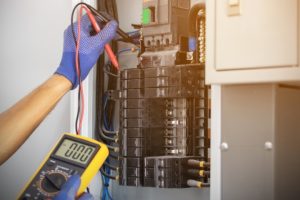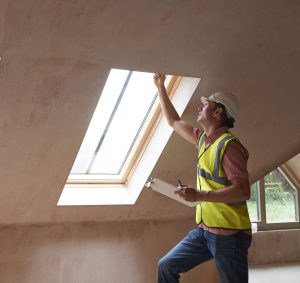The Barrie Home Inspector discusses the twelve most common items found during a home inspection. These are items that are commonly found during a home inspection but are listed in any order of importance.
1. Lot and Roof Drainage
Keeping water out of your house in one of the most important areas to be considered in building design and annual maintenance checklists. Eave troughs collect large amounts of water, average is 160 gallons per hour, which is then directed down to ground level to be dispersed. This is where most systems have problems, from missing extensions to reversed splash pads, and it is important to ensure all water is directed away from your home. I have actually come across homes where the sump pump was pumping water out into the exterior corner of the house where the water ran right back down the foundation to be re-cycled again. Areas around foundations are prone to settling and should be built back up to ensure that any water will flow away from home.
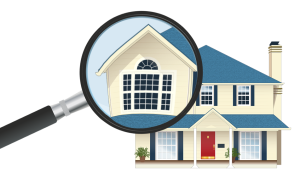
2. Foundations
The primary function of the foundation is to transfer the load of your house unto your footings. Water can enter your home through cracks and holes in your foundation. Cement block foundations are required to be parged and then coated with damp proofing product to prevent this. Poured concrete foundations are required to have form holes sealed to prevent water entry. Minor cracks in foundations can be attributed to settlement of building or shrinkage cracks which would appear in poured concrete foundations. Any crack in your foundation is a potential source of water entry into your basement. If your area has excellent drainage and surface water is not an issue then sealing your cracks yourself could be an option, if not then a professional will seal poured concrete cracks using injected foam or epoxy for around 3 to 600 dollars. Sealing with epoxy will make the cracked area stronger than surrounding untouched area. Horizontal cracks in basements are stress cracks and usually should be inspected by engineer to ensure safety of the home.
3. Cladding
There are many types of cladding used in homes today, we are going to discuss brick veneer and vinyl siding, the most common types of cladding used in new homes in Barrie, ON.
Brick – There are two common types of brick in use today, clay and cement bricks, clay being the most expensive and more durable of the two. The most common defects in brick are caused by poor workmanship and settling of the house or foundation. Checking the brick work for cracks in mortar is very important part of your home inspection. Finding cracks prior to moisture and freezing damage occurring can drastically reduce the amount of work required to repair problem. Corbelled brick corners are an area where cracked mortar is very common but is an easy fix. Step cracks usually indicate a structural type problem is present and deeper investigation is required. Home owners can cause damage to bricks by building planters which allow soil to contact brick, this will result in spalling of brick face and eventually the brick will crumble and require replacement.
Vinyl Siding – This product has proven to be an attractive and low maintenance alternative to brick. If not properly installed vinyl siding can come loose which will make it very susceptible to damage. Properly installed siding has to be able to expand and contract without warping, this is done by not hammering in nails tightly and the fastening slot will allow siding to expand and contract with changing temperatures. Washing your vinyl siding spring and fall is also a good idea as this will help prevent staining from air borne contaminants. Vinyl siding is susceptible to cracking, especially in winter months when cold temperatures can make it extremely brittle.
4. Windows
Windows come in all sizes and shapes with many different types of opening models. We are going to concentrate on mainly the casement style window, as this is the type of window, which commonly has defects. Casement windows commonly have problems with the cranking mechanism. Stripped windows cranks are commonly found on windows in children’s bedrooms and are mainly due to the fact that in the winter these windows tend to freeze up and then when the crank is operated, a stripped mechanism results.
Broken seals in thermal units are another common defect found in windows. Windows around 15 years, and older, are usually found to have problems with leaking thermal units. There is a process that involves inserting tiny one-way vents into these units which can eliminate the moisture problem and save you money. The “R” value of windows is not so high that this procedure would create a huge heat loss.
Then there is the common defects in windows, which can include, no caulking, cracked glass panes, improperly trims, sagging headers above windows, require painting and last but not least cracked or rotting wood.
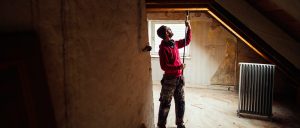
5. Roof
We are going to concentrate on asphalt or fibreglass shingles as this is by far the most common type of product used in new homes today. Shingles can last anywhere from 15 to 25 years depending on quality of product and environment that they endure. Shingles on south side of home usually fail first due to greater exposure to sun and UV radiation. Proper venting is a very important factor that can greatly affect the life of your shingles. Building code requires 1 square foot of vents for every 300 square foot of roof. Ensuring adequate venting is important part of home inspection, a lot of homes have inadequate soffit venting due to insulation preventing continuous movement of air. This allows moisture and heat to build up in your attic and will dramatically reduce life of shingles. Inspecting flashing, valleys, skylights, vents and eave trough are another important factor of your home inspection. Ensure your inspector has a ladder and walks your roof if he is able.
6. Furnace / Air Conditioning
Furnaces have an estimated life span of 15 to 20 years and this can vary greatly with maintenance being the biggest factor in extending life of your furnace. Your furnace cannot have any holes, be rusted through in any area and must be hooked up to an approved venting system. If connected to a “B” vent, a one-inch clearance must be maintained from combustibles, which also includes insulation. Check your flame color, yellow flames indicate incomplete combustion which may be fixed with a simple tune up from your furnace technician. Many furnaces have no cap for filter cover which allows for both heat and cold air to escape into your basement. Your HVAC duct should be taped using metallic duct tape to block any areas where air is escaping from your system. Humidifiers are a common cause of water source for damaging furnaces; they become clogged and overflow allowing water to enter body of furnace causing premature failure of unit.
Central air conditioners are essentially a sealed unit. Using a temperature gauge can determine if unit is operating at a level that is acceptable. I use 58 degrees F as a bench mark in testing in hot weather. This ensures that unit will maintain your home at a comfortable temperature. All lines and insulation are checked for any damage or required replacement.
7. Electrical
The number one concern for homeowners and insurance companies is aluminum wiring. Installed in the early seventies as a substitute for high price copper, aluminum has generated a lot of negative press, some maybe not deserved. Knowledge of aluminum wire is required to be disclosed by the home seller. Consequently some people are creatively hiding aluminum wiring. This might involve installing wire so insulation covers all exposed wire and running copper from main panel to junction boxes where it is connected to the existing aluminum wire.
Adding pony panels, which allowable and recommended, is a great way of expanding your main panels resources. I came across one pony panel, full sized 100 amp, which was powered off supply cables in switch box. This panel was noted in listing as an asset! There are a myriad of minor electrical problems to be checked in your home. Another main panel observation is that many people rather than add a breaker just attach two or more wires to an existing breaker, this is a not permitted and is a potential fire risk. Open junction boxes, missing covers, wiring contacting heat ducts and un-supported wiring are common defects noted on majority of inspections.
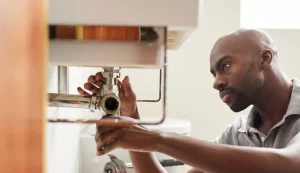 8. Plumbing
8. Plumbing
The other half of the keeping water away from your house equation is your interior plumbing system. Lack of caulking and sub-standard products or workmanship is also a big offender when it comes to keeping your house dry. Galvanized pipe is another item that insurance companies may be concerned about. Galvanized pipe tends to corrode from the inside out leaving no visible signs of impending failure, which tends to make insurance companies a little nervous about insuring homes with galvanized plumbing.
9. Insulation
Homes today have a much higher insulation R-value than older models, the standard for your attic insulation is R-32. Coupled with vapor barriers this is a very important part of your homes building envelope. Many homes have lots of insulation but it has been compromised by workmen installing products such as pot lights and never remedied. The un-suspecting homeowner never realizes the loss of heat and release of moisture that is taking place. I have inspected homes where there has been sun rooms added on and for two or more years that complete area has not had any insulation.
Vermiculite insulation is receiving a lot of attention due to asbestos hazard. Most vermiculite was produced from Libby mine in Montana and contains asbestos. There is some type of vermiculite that has no asbestos risk, which can only be determined by laboratory testing. Homeowners are obligated to disclose any vermiculite insulation that they know of. This is another area where your home inspector can help and possibly save you a lot of money and headaches.
10. Mould or Mold
We are addressing both Canadian and American mould or mold problems, eh!
Mold has been a inspection headliner for quite a number of years. Mold is present everywhere, outside, in your home and sometimes even in the wood you are building with. Moud requires three items to grow, they are; warm environment, protein supply (paper on drywall will do) and moisture. As you can see if you have any water or moisture problems in your home for any length of time then you probably have mold somewhere in your home. That is why it is so important to keep water out of your home and control the water you do have in your home by the proper use of exhaust vents, HRV units and humidity control.
11. Structural
The structural component of your home includes all the items that comprise the supporting elements of your home, which include but are limited to; footings, floors, foundation, walls, columns and piers and roofing system. Visual inspection involves looking for cracks, missing supports, under-sized support construction, twisted or cracked beams, joists, rafters, trusses or support members. Consider your structure as the exterior and interior framework that encompasses your home. Defects in this system can be considered serious and should not be taken lightly as you whole home depends on this system.
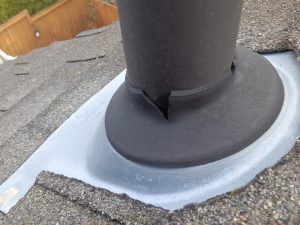 12. Miscellaneous
12. Miscellaneous
Here is a quick list of some of the items that I have come across that might not have been discussed above:
Septic tanks – Water pooling at the end of your bed or signs of effluent leaking are sure signs that you have some kind or septic bed problem. Buyer beware!
Chimney – Masonry chimneys can be visually OK but not approved for type of appliance you are using. Wood stoves and fireplaces usually require WETT cert for insurance.
Caulking – Any two different surfaces that are exposed to weather should be caulked. For example your window and siding should always be caulked.
Trees – Ensure there are no dead trees on property that might damage your house or any of your neighbor’s property. Also trim branches away from any siding or roofing product.
Concrete Steps – Must be either cantilevered or on frost footing.
Handrails – Required to be 900 mm high in most exterior applications.
Decks – If over 23 5/8 inches (600mm) from ground are required to have guards & handrails.
Basement Bedrooms – Required to have separate exit on same level or window that is minimum area of 0.35 M2 with no dimension being less than 15 inches (380 mm).
Bathrooms – shall have either exhaust fan or opening window.
Hot Water Heater – Safety Pressure valve shall have vent directing blow-off to floor.
Garages – Required to have fume barrier and auto door closure if interior door installed.
These are just some of the common types of defects encountered during a residential home inspection, there are thousands of items that could possibly be identified.

